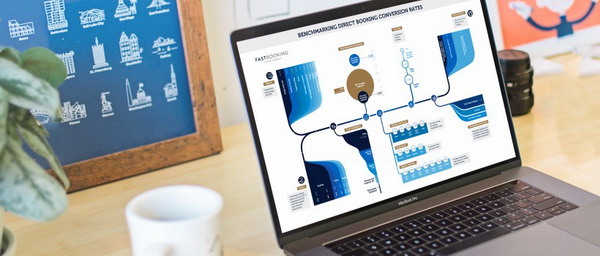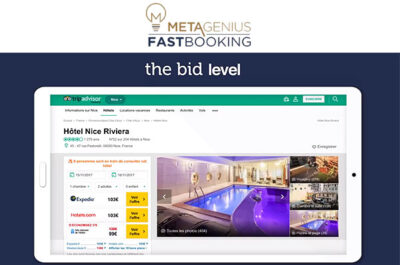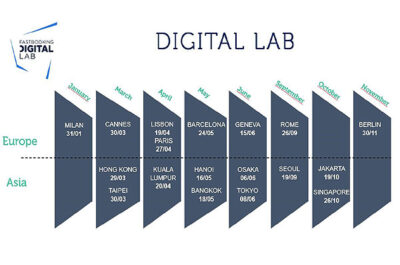The conversion rate of a hotel website is determined by so many factors that one shouldn’t be fooled into trying to meet an industry average. Instead one needs to understand the factors that make up those rates and try to improve each point.
The average hotel website conversion rate is 2.2 percent, with the top 20 percent of hotels having an average conversion rate of 5.6 percent and the bottom 20 percent having a conversion rate of 0.3 percent. These are sweeping averages which might be practical when benchmarking one’s hotel but are almost always impossible to use individually.
The conversion rate of a hotel website is determined by so many factors that one shouldn’t be fooled into trying to meet an industry average. Instead one needs to understand the factors that make up those rates and try to improve each point.
As a full service hotel distribution and technology company in FASTBOOKING we have access to thousands of hotel website data. As we frequently get asked what is a good conversion rate, we have done a deep dive into the data from hundreds of hotels across the world, in big cities, small cities, on beach resorts or business locations. We’ve looked at hotel chains, groups and individual hotels to put together a broad set of data.
From all that research and looking and working with our experts and client advisors we’ve put together an overview of what makes and what breaks hotel website conversion rates and what hoteliers can do about it. Including some tips on what one should or shouldn't worry about.
“What is a good conversion rate for my hotel website?”
Is a question we get asked very often, answering it may be way harder than you think. First of all, what do we mean by the term conversion? According to Google, a conversion occurs when a website visitor (or app user) performs an action defined as a goal.
This leads to the next logical question: what does that mean for the hotel industry? In Hospitality, with the generic term conversion rate we refer to the ratio between the website sessions and completed reservations.
To measure a hotel website’s conversion rate and keep an accurate comparison we have defined conversion rate as the number of reservations made compared to the total number of sessions of a website for the same time period.
Example of conversion rate:
| Monthly Sessions | Reservations | Conversion rate |
| 6,553 | 144 | 2.2 percent |
We have also decided to present data using last click attribution model only. As you may know, the limitation with this model is that it gives 100% of the conversion credit to users last touchpoint, making it hard for marketers to measure interaction and brand engagement through the whole booking journey. On the other hand, even though conversion attribution is one of the hottest topic in our industry (especially since Google launched a free simplified version of Attribution 360 back in May), it is still common practice to calculate conversion based on users last interaction with the brand and chances are that you or your web agency are using this model as well. So, for the sake of ease and in order to provide numbers you can easily compare with your own, we preferred to use last click attribution model, despite its intrinsic limitations.
We also decided not to take into account any cancellations. According to a Mirai study, hotel official websites have an average cancellation rate of 19 percent. That it is, therefore, a variable you may want to take into consideration when calculating your conversion rate. So why we decided to discard cancellations? The reason for it is that cancellations usually happen closer to the stay day, thus the current month’s conversion rate (with no cancellations yet) compared to the conversion rate of same month last year (having retroactively removed cancellations) would give a false sense of improvement.
Let’s take a second look at the example above:
| Monthly Sessions | Reservations | Conversion rate |
| 6,553 | 144 | 2.2 percent |
Let’s assume this is the conversion rate of your website in November 2017. To simplify even more, let’s pretend that all these reservations are done for December and January. In those two months, anyway, 27 reservations will be cancelled. Now, if you look at the above example again, you will see that those original 144 reservations turned into 117 real ones, lowering your conversion rate from 2,2 percent to 1,78 percent. But, as you will not be able to analyze your data retroactively for the current month, if you do not discard cancellations when calculating your conversion rate, this will always look better than the previous year, even though it may not be.
As a final note on the methodology used: as stated in the opening, it is crucial to keep things in perspective and understand the bigger picture when calculating conversion. Larger room hotels tend to have more traffic and, thus, lower conversion, because they usually do not sell exclusively rooms, but congress facilities, F&B services and wellness treatments as well. All these ancillary services attract a lot of traffic on the website, but it is mainly local traffic that is unlikely to convert into room bookings. Even though meeting requests, dinner reservations and massage appointments are (in fact) conversions, in this study we are focusing exclusively on room transactions. So, if your hotel sells non-room services as well, we suggest to segment your traffic in Google Analytics by excluding the sessions of the meeting & events, restaurant and SPA pages and re-calculate the conversion rate based on the remaining traffic, filtering these users out of the data set.
Conversion rate by Traffic Source:
Dozens of variable plays a role when it comes to conversion rate. One of those is the quality of traffic. As a general rule, the more pertinent the traffic the higher the conversion rate.
With that in mind, it comes with no surprise that targeted advertising campaigns register the best conversion rate, with Google Hotel Ads at 4,17, Facebook Display at 3,21 and Tripadvisor metasearch PPC Ads at 2,34 percent respectively.
Google AdWords when used to protect the hotel brand name has an average conversion rate of “only” 2,05 percent but this data is not entirely surprising when put into today's market context.
Back in 2014 Tom Mulders, Google's senior program manager for GHA (Google Hotel Ads) , publically stated that “Google is expected to gradually shift more and more traffic to Google Hotel Ads, possibly at the expense of AdWords and organic SERP”. With Google slowly but surely pushing organic results and Adwords below its metasearch, it is normal to see a decrease in conversion for search engine ads, as visibility plays a big role in CTR and, therefore, conversion.
Retargeting tends to convert extremely well (2,19 percent conversion rate), over twice the average conversion of display pre-targeting (0,92 percent). That is normal, as the users that visited your website showed an active interest in your property and they are way further the booking journey funnel. In those cases, a little extra push from retargeting can really boost your conversion rate.
Advertising aside, direct traffic is, obviously, one the most qualified source and with its 2,20 percent conversion rate, falls just behind Google Hotel Ads, Facebook display and TripAdvisor metasearch ads.
Organic search, on the other hand, performs averagely, with a 1,55 percent conversion rate, this comes partly for the same reasons as the lower AdWords traffic and partly because organic search also includes “long tail” traffic such as “spa in London” or other such traffic which doesn’t convert into room nights.
It’s interesting to highlight that even Trivago, historically a great source of traffic but not always satisfying in terms of ROI, have a slightly (+0,12 percent) better conversion rate than organic traffic.
At the bottom of the conversion rate podium, unsurprisingly, we have blogs, with only a 0,20 percent conversion rate (to put data into context: blog conversion is 20 times smaller than Google Hotel Ads conversion), indicating how much blogs and influence marketing, in general, tend to affect the “I want to get away” micro-moment, when the traveller is still at the early stages of his planning. This doesn’t mean the traffic isn’t important, it is part of your brand awareness, but since it is so early on the conversion funnel it is not often visible especially not on the last-click model.
Takeaway tip:
Metasearch campaigns and Facebook ads tend to have the best conversion, while SEA, organic / direct results and referrals (blogs) average conversion rate is slowly decreasing. Shifting some advertising budget from classic search engine advertising to metasearch and social ads can be a good way to get better ROI for your property.
Conversion rates by Device:
According to web analytics company StatCounter, on October 2016, internet usage on mobile devices exceeded desktop for the first time worldwide in the western world.
Unfortunately, conversion rate did not follow that pave with European and US guests. Which is not unexpected, as booking a hotel is usually not an “impulse buy”, it takes a long time in planning, multiple touch points and plenty of price comparison.
In Asia however this trend is quite different, where mobile is is often the main device used also for booking. Japan and China have been leading the mobile first trend with far more advanced payment systems making mobile conversions more common than most western countries.
According to Google, the travel booking journey to the actual reservation is almost two month long, with eight travel websites involved in the process and, of course, multiple devices used.
Navigating on mobile devices is quite different from desktop devices. On a desktop one tends to be more focused on an action and completing it, whereas a mobile is used to check rates, images, information in small fleeting moments. While watching TV, in the subway and so forth.
This affects conversion since those small moments aren’t destined to purchase especially not a larger expense such as a hotel stay.
Then there is a more technical issue which is payment methods. The lack of an easy and standardized payment method on hotels booking engine industry, for example. Keeping your iPhone in one hand and your credit card on the other can be a frustrating experience, especially on smaller screens. On top of that, lack of responsiveness on your website can highly affect conversion rate.
That explains why in 2017 mobile conversion was barely 0,8 percent, with only a 0,2 percent increase over the previous year. Compared to a mobile traffic volume of 50% (and growing by over 10% each year).
To put things into perspective, desktop had a 6 times higher conversion, with 4,5 percent in 2017 and 4,1 in 2016. Tablet conversion rate was in between the two devices, with 2 percent in 2017 and 1,8 in 2016.
The oddity is that sometimes hotels see their conversion rate drop when they add a new mobile website. The reason for that is that with a well optimised mobile website, the website tends to improve in ranking and capture new traffic from mobile devices. As it doesn’t convert as much as desktop it gives the impression of reduced conversion rate.
Takeaway tip:
We recommend hotels have highly optimized hotel websites to take in the increased traffic, use other means of contacting the guest such as chat and call-back systems to interact with the guests so they can make their reservation through other channels. And to work with providers that can accept the mobile payment systems.
Conversion rate by Location:
"Location, location, location" is a phrase associated with real estate and hotels since the 1920s. That is why a study on conversion rate cannot ignore this important variable. We broke down our hotel panels into three main categories: capital cities, major cities and seasonal touristic locations.
Results were pretty apparent, with properties located in capital cities (2,56 percent average conversion) overperforming major cities ones (2,35 percent) and seasonal touristic location (1,78 percent).
This is not entirely bad news for touristic location, as it is important to highlight that, while capital and major cities hotels tend to sell their rooms directly to the final guests via their official website and OTAs, seasonal hotels and resorts rely more on intermediaries that sell the hotel indirectly to third parties (tour operators, wholesalers, travel agencies, GDS, etc.).
Conversion rate by ADR and Rate Strategy:
Another unsurprising factor that highly affects conversion rate is the average hotel price. Of the data set we analyzed, properties with daily rates below 150€ per night have twice the conversion of the ones selling at 900€ and above (2,74 vs 1,35 percent).
Booking a cheaper hotel, a motel or a B&B is obviously an easier action than organizing a luxury travel, so expensive properties are disadvantaged in terms of pure conversion rate, even though the average booking value is way higher than cheaper properties. Besides the higher end hotels also have still a larger number of phone reservations as guests want to make sure their needs are taking into consideration.
On the ADR variable case, the data we analyzed formed a clear descending curve: hotels between 150 and 300€ ADR have a conversion rate of 2,41 percent, hotels between 300€ and 600€ 2,28 and hotels between 600€ and 900€ 1,85.
There are more factors that come into play on this which is how high end hotels also tend to have more sessions and often sessions for people who are just curious about the hotel. It often happens that they are mentioned in an article or on social media which inflates the website sessions.
This, anyhow, is not the only conversion variable when it comes to prices: in fact, offering a better rate on your official website can boost conversion by up to 67 percent, while giving discounted rates on OTAs and other distribution channels can decrease it by 77 percent.
Takeaway tip:
Non refundable rates, have 3 times lower chance of conversion than flexible ones, so make sure you offer a refundable rate to your potential guests. In conclusion, hotels with lower ADR that breaks parity rate tend to have the best conversion rate, while more expensive hotels that respect rate parity contract clauses are more likely to underperform when it comes to conversion rate.
Breaking down the booking funnel
To help breakdown how the booking funnel happens on hotel websites, we worked out the averages based on how it would look like if 100 people were looking at the average hotel website.
We’ve tried to help explain the various steps to illustrate how the path develops.
• For 100 visitors entering the website about 42 will click to check rates (and/or availability) this shows an interest in the hotel but too many variables are still unanswered and the drop off will be substantial.
• From the 42 visitors that are interested in the hotel, 9 will find that the rates and availability fits their needs and move to further step in the booking process. But they still need to complete the reservation.
• From the remaining 9 visitors, 7.5 will click through to the credit card and personal information page. Some will return to another channel to book because their payment data and personal information is already stored. Some will click through to verify that there are no hidden costs.
• 2.2 will complete the booking.
User Experience and its impact on conversion
Driving qualified users to your official website is obviously very important, but it is even more important to give these users a proper page to land on, a poorly designed website with a frustrating User Experience can dramatically reduce your conversion rate.
How can you make sure your official website is ready to transform users into guests? A couple of months ago we wrote a full guide and infographic about how to choose the right distribution solutions for your hotel, with an entire paragraph dedicated to web design best practices, so you may be interested in reading it to deepen the subject.
There are some basic rules to follow when it comes to web design for hotels, with the most important being: choose a web agency with proven knowledge of the industry.
Most of travellers are looking for answers to three questions on a hotel website: Rooms, Rates and Location, so it is crucial to clearly answers those questions as fast as you can. An agency specialized in Hospitality knows how the average user behave on a travel site and will design the website based on those behavioural patterns.
Here at FASTBOOKING, for example, we have frequently doubled the conversion rate of several of our clients just by upgrading their website’s design. A frictionless design website with high definition professional photos can have a dramatic impact on conversion, as it creates an emotional impact on the user.
Kevin Roberts, CEO of Saatchi and Saatchi once stated that “reason leads to conclusions, emotion leads to action.” And, as we wrote in the introduction, a conversion is nothing else that a specific action users do on websites, so do not underestimate the power of emotion when selling your rooms.
Another important conversion variable is the time it takes to load your website: an Akamai research showed that a 1 second delay in page response can result in a 7% reduction in conversions, so make sure your website is hosted on a proper servers and use content delivery network (CDN) in order to quickly load pages to virtually every user in the world.
We already explained how mobile took over desktop in internet usage, so it is easy to understand that responsiveness of your website is another crucial factor when it comes to conversion rate.
With all that in mind, every website need tweaks and adjustments from time to time so, in order to be sure that the User Experience on your website is frictionless, analyze your website’s bounce and exit rates frequently, test the page load time from different locations and if you really want to understand how people use your website, install a heat map tracking system.
Conversion Assistants: widgets
Even when all the previous points are optimized, there is still some room for improvement: third party widgets, in fact, can really boost your conversion rate, provided that they are chosen according to your specific needs. According to our data, for example, price comparison tools (widgets that displays real-time OTA prices together with your website’s) improve conversion by an average 30% but, if your hotel is respecting OTAs rate parity contractual clauses, this kind of implementation could not be the best way to go. Same goes with review widgets: integrating one of them on your site or on your booking engine can boost conversion up to 15%, but if your reputation is not pristine this can be a boomerang. A live chat (whether a human being or a bot is behind them), on the other hand, is always a safe choice: +15% conversion improvement on average, no matter your rates nor your TripAdvisor ranking. Widgets are a great opportunity especially for independent hotels: you can easily integrate them without developing the whole technology from scratch (usually you only have to add a few lines of code on your website) and they are relatively inexpensive. There are several companies out there providing quality tools: TripTease, for example, even though it started offering a wider range of products lately, is mainly known for its state-of-the-art price comparison widget, Hotel Direct Booster offers a beautifully designed livechat system, with an average speed of answer of only 30 seconds and TrustYou's semantic technology processes billions of data, providing easy to read aggregated review score, in order to give travelers all the key info they are looking for.
Conclusions:
As you have undoubtedly noticed there are many factors that affect the conversion rate of a hotel website. Many you can control (rates or reviews) and many that you don’t control (location or availability).
The single most important factors to improve conversion are the following three:
• Rates: having competitive rates and offering a better rate to the travelers for booking directly on your website is the single most efficient way to increase your conversion rate.
• Trust: having great reviews will affect your conversion rate. A recent research by Donna Quadri-Felitti, academic chair and clinical associate professor at New York University showed that, given equal rate, travelers are almost four times more likely to book a hotel with higher review score.
• Service: Showing that you can offer a better service such as more flexible rates or other benefits will encourage conversions especially if this is something unique that is only offered on your website.
Looking only at conversion rate one can miss the bigger picture which is the number of sessions and the revenue it generates. Measuring one’s website efficiency is a composite of website sessions, conversion rate and revenue one must balance those three to achieve the final benefit of profitability which enters the fourth factor and that is resources spent to achieve the revenue.
Fastbooking – Benchmarking Direct Booking Conversion Rates by Tatiana on Scribd
From the beginning, alongside the founders, Jean-Louis Boss has been a key player in FASTBOOKING’s development, especially its digital business. A marketing specialist, Jean-Louis took charge of overseeing statistical analyses at the Yves Rocher Group, where he rose rapidly up the ranks and became the Director of International Development. His experience with internationally renowned brands enables Jean-Louis to bring to FASTBOOKING real client expertise in terms of positioning and online sales development.




























































































































































































